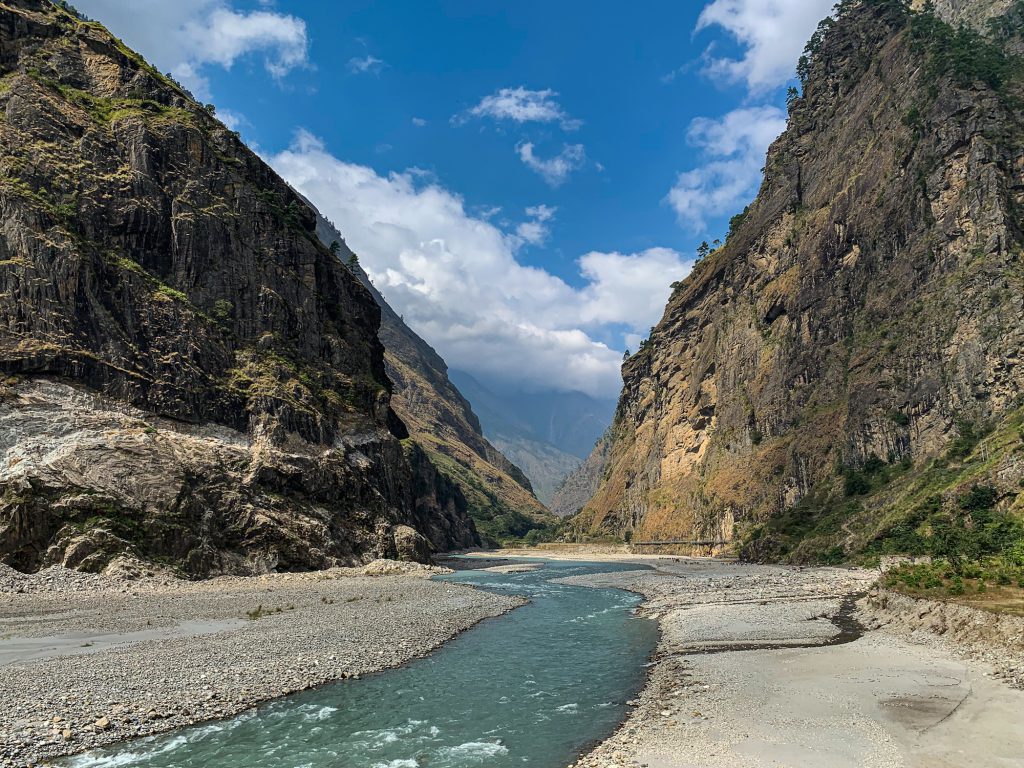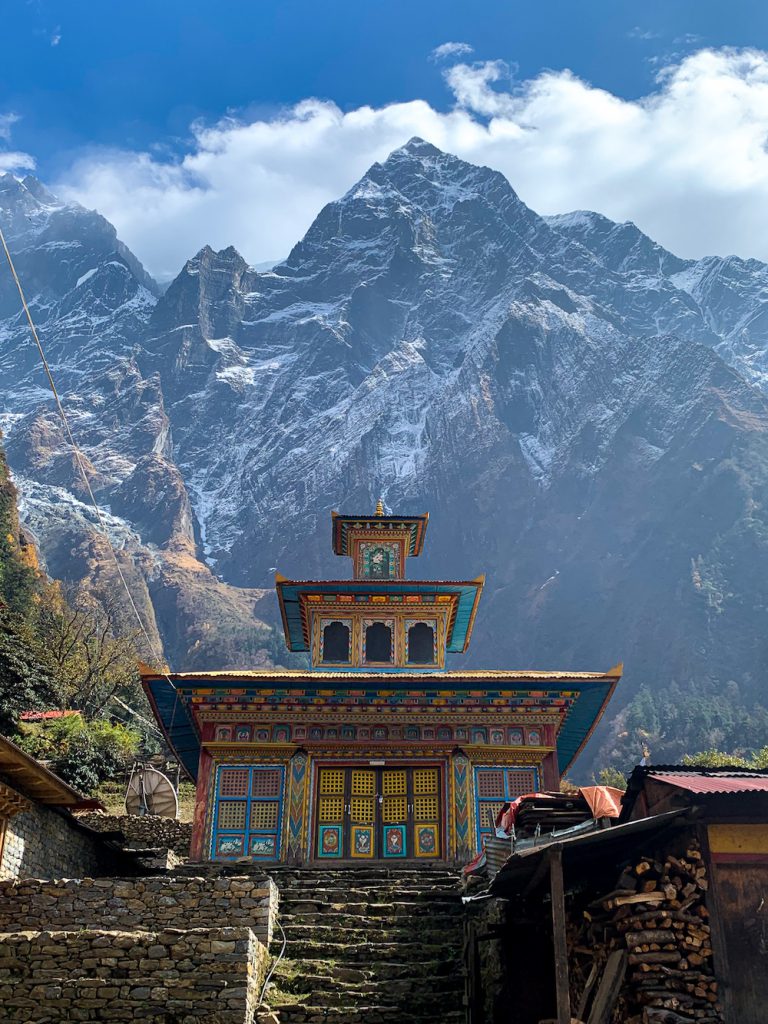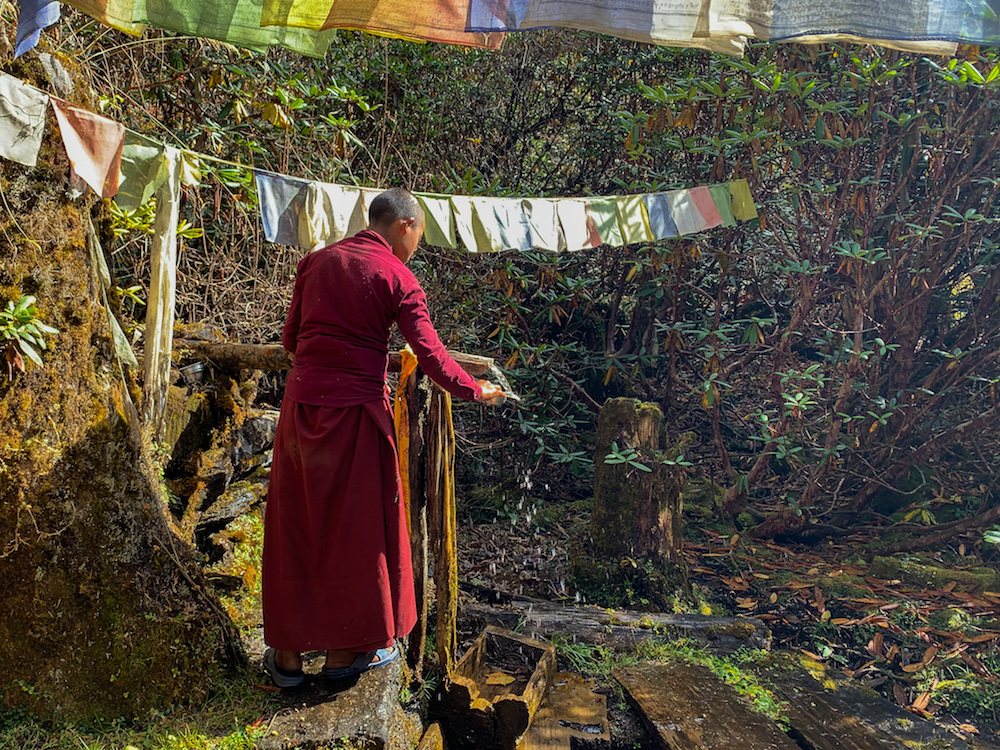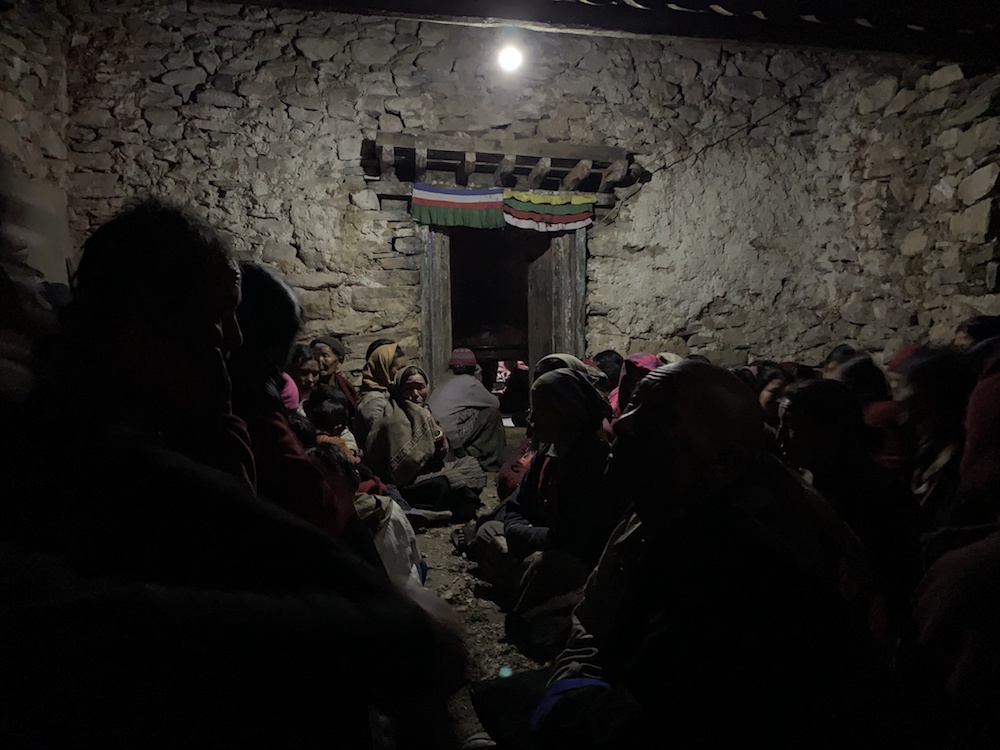A Nepalese Region Reclaims Its Holy Water

“I’ve been told this is the longest suspended water system in Nepal,” Mitch Silver, a self-described high-altitude plumber, explains as we climb the treacherous cliffside, following the narrow pipeline that hangs above our heads. “People just don’t do this—run 300, 400 meters of cable across a gorge for a pipeline.”
Gravel breaks loose with each step, tumbling more than 100 meters down to the icy blue river that rushes from the Himalayan peaks that surround us. This pipeline is significant for more than its record-breaking design; it is carrying water from a drubchu, a holy spring, to the Serang Monastery in Nubri Valley, one of the most sacred and remote highland regions in the Tibetan Buddhist world. People walk for days to drink this spring water in hopes of benefiting from its healing power.
“According to a point of Buddhism, water is the most valuable and most important thing because of its connection with disease,” says the monastery’s facilities manager, Urgyan. “Clean water helps everything: healthy body, healthy mind.” Nowhere are people more aware of this in Nubri Valley than in Prok (known locally as Trok), a village of about 50 households located one long day of difficult hiking from the Serang Monastery.
In just a single generation, residents report that the settlement’s infant mortality rate dropped from about 25 percent to 4 percent. How could such a drastic change happen so quickly? For residents of Trok, the answer is clear: Life in the village was revolutionized by the construction of a tank system high in the mountains. In this valley, people know the transformative power, both spiritual and biological, of water.
Nubri Valley, an ethnically Tibetan region in the Gorkha District of Nepal, is one of seven valleys, known as beyul, hidden deep within the Himalayas. The valley’s four villages and eight smaller hamlets, ranging in elevation from 2,130 meters to 4,460 meters, are home to around 2,000 people. Settlements lie along the Budhi Gandaki River between Manaslu (known locally as Pungyen, the eighth-highest mountain in the world) and Serang Himal, a subrange of the Himalayas.
Entering a beyul is physically and mentally challenging; these earthly paradises are said to be only for the worthy. According to teachings from the Nyingma School of Tibetan Buddhism, the oldest of the four major schools, these are places blessed by Padmasambhava, an eighth-century saint who spread Buddhism across Tibet and the Himalayas. Believing that the local population was not spiritually ready to receive all the teachings at once, Padmasambhava hid treasures, such as sacred texts, in the beyul to be uncovered as people progressed through their journey to enlightenment.
If entering a beyul is hard, living in one is harder. Nubri’s mountainous terrain of plunging gorges and sheer peaks poses year-round threats to life and livelihood, and limits road access while new roads further exacerbate ecological challenges. The 2015 earthquake caused the destruction of almost 80 percent of houses in the valley. In addition, while not geographically far from Nepal’s bustling capital Kathmandu, Nubri is separated by difficult topography as well as ethnic, cultural, and linguistic differences. In a nation where Hinduism dominates, the area’s Tibetan Buddhist highlander lifestyle seems to many other Nepalis to be more fitting in a different country, and most people in Nubri Valley identify much more with their Tibetan heritage than with Nepal.
Down a side valley, surrounded by old-growth forest and snowy peaks, sits the Serang Monastery. “This is a very special place, not just for the local community, but even for world peace,” says Nuptul Tenpei Nyima (Tulku Palsang). His title tulku indicates he has been identified as a reincarnated lama, a spiritual leader and master who has agreed to continue being reborn to assist others on the path to nirvana.
I met Tulku Palsang in his serene office over a thermos of salty butter tea on a visit to the monastery last November. I was there as part of a larger project studying the causes and impacts of Nepal’s water insecurity, primarily in Kathmandu Valley. The Nubri Valley case study gave me the opportunity to analyze the impacts of a Tibetan, mountainous, and rural context as opposed to the Hindu, urban one of Kathmandu, which I focused on during my yearlong research fellowship. How have these cultural and geographical differences impacted local responses to water insecurity?
Stepping through the Serang Monastery’s front gate feels a bit like entering a Buddhist paradise. The scent of burning juniper fills the air, and young monks with red robes and shaven heads play soccer, dodging the wild mountain goats (Himalayan tahr) that graze peacefully, unafraid of humans. In a place like this, it seems fitting that the water people use for everything, from religious ceremonies to brushing their teeth, would be considered holy.
The first time Silver (the high-altitude plumber) visited Serang in 1985, it was open only to serious religious practitioners. While he has studied Buddhism extensively, the Hawaii resident said he would not typically qualify as someone worthy of entrance. But because Silver knew the leader of the monastery, he was given special permission to visit, thus beginning his long connection with Serang. In 2015, Silver, who has worked on engineering projects in Nepal for more than 40 years, was hired as an independent contractor to construct a small-scale hydroelectric system. He realized the monastery had a greater need for water than electricity, so he switched gears to his other area of expertise: water systems.
Although stringing a pipeline above a gorge a couple hundred meters above the valley floor was an engineering nightmare, the difficult design made sense considering the significance of the water. In addition to the connection with the saint Padmasambhava, lamas at the monastery claim there is proof that the water has healing properties, particularly in curing speech impediments in children. Tulku Karma, the other tulku at Serang, is quick to say that “scientifically, the water has never been tested, so we don’t really know.” But ultimately, he and the other residents of Serang are less concerned with the properties of the water when its effect on the way of life at the monastery is so visible.
We live in a world plagued by water problems.
Before the system was constructed in 2015, water access was inconsistent, especially during the long, harsh winters. Large parts of the day were spent collecting and hauling water or melting snow. Although the new system is not perfect—the pipes freeze and the pipeline is occasionally damaged by frequent avalanches that crash down the valley—it is a drastic improvement.
Limited water access was the main factor preventing the expansion of the monastery. Now the monastery, a community of around 100 monks and nuns, has built a primary school for children from all over the valley, currently numbering around 100, with plans to add more classes. “Those who want to practice the dharma no longer have to worry about the basics. They can purely dedicate their practice,” Tulku Karma added.
Because the vast majority of people in Nubri Valley practice Buddhism, Serang is a central and revered place: Most try to visit once a year, and the monastery maintains its relationship with the surrounding communities by regularly sending monks and nuns to the villages to perform puja, or religious rituals. Traditionally, at least one child from each family would join the monastic life, and many would be sent to Serang. This practice continues, although in reduced numbers, as many are leaving the region for education and work opportunities in the capital of Kathmandu and abroad. Regardless, for most people in the village of Trok, Buddhist practice remains one of the core tenants guiding daily life.
The practice of Buddhism in Nubri is melded with local belief systems that ascribe meaning to the physical surroundings and emphasize a symbiosis between humans and the deities who inhabit the landscape. One of these deities is Tsomen Gyalmo—meaning Queen of the Lake—who resides in Kal Tal, a high-altitude lake above Trok that also serves as its primary water source. Residents of Trok perform yearly rituals at the water’s edge, circumambulating the lake and giving offerings.
In deference to their protector goddess, maintaining the purity of the water is essential. Kunsang, a young researcher from the area, says her aunt directly witnessed the consequences of polluting the water shortly after I visited Trok. One day, when she and her son were collecting wood, her son came and told her he had peed in the chu mig, natural spring. She had chastised him for polluting the water, but it was too late.
Following the event, he became sickly and irascible. No one knew how to manage or prevent his sudden outbursts, so they took him for divination. It quickly became clear to the priest that the child’s problems were the result of the incident at the spring, and, Kunsang says, the boy’s temperament has still not returned to normal.
Far below Kal Tal, on a wide plateau above a river valley, sits Trok. Its clusters of houses are surrounded by farmland that is tended by women in traditional Tibetan dress with patterned aprons, their hair pulled back by scarves, and men leading their yaks down stone-paved pathways that divide the plots. Smoke wafts through the crisp air, a sign that cooking is happening on the wood-burning stoves that blacken the interiors of the windowless homes.
Just 20 years ago, the village faced a dire problem: The infant mortality rate was staggeringly high—higher than that of the surrounding villages. Amche Dorje, an elderly resident, says he saw that for much of his life in Trok, most women spent virtually all their reproductive years pregnant, having child after child in hopes that at least one would reach adulthood. People began noticing a pattern. Those living in the downstream part of the village became ill much more frequently than those upstream. It was clear that there was a connection with the water and that something needed to be done.
Although Kal Tal has been carefully protected, when the water reached the settlement, it was used for daily chores and for sustaining livestock, but this also made it vulnerable to contamination. A large percentage of the village population was often ill, and infants were impacted more critically. To ensure that all residents had access to clean water, a tank system was constructed above the village to collect and filter water from Kal Tal, which is then sent to public taps. This, plus the implementation of health trainings grounded in local belief systems, have helped decrease the infant mortality rate.
Women now spend fewer of their reproductive years pregnant, which enables them to take on other roles in the village, and their children have more opportunities to pursue higher education. “That’s the biggest change to happen in the village, and all of this has come from the water,” one resident explained.
Too much water, not enough water, dead rivers, and rising tides—we live in a world plagued by water problems. While it is true that most of these problems require more complicated solutions than building pipelines, the case of Nubri Valley shows the kind of revolutionary change that can happen when people understand the interaction between everyday lives and natural resources. Residents in the valley say that the reason they get to live there and drink the water is because they accumulated good karma in their previous life. Whether or not it is considered holy, water heals, opens doors, and creates pathways.


































